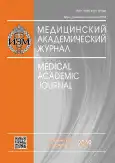СОВМЕСТНОЕ АНТИБАКТЕРИАЛЬНОЕ ДЕЙСТВИЕ КАТИОННЫХ ПРОЛИН-БОГАТЫХ ПЕПТИДОВ СЛЮНЫ И АНТИМИКРОБНЫХ ПЕПТИДОВ
- Авторы: Сухарева МС1,2, Копейкин ПМ1, Жаркова МС1, Шамова ОВ1
-
Учреждения:
- ФГБНУ «Институт экспериментальной медицины
- ФГАОУ ВО «Санкт-Петербургский политехнический университет Петра Великого»
- Выпуск: Том 19, № 1S (2019)
- Страницы: 180-181
- Раздел: Статьи
- Статья опубликована: 15.12.2019
- URL: https://journals.eco-vector.com/MAJ/article/view/19388
- ID: 19388
Цитировать
Полный текст
Аннотация
Слюна является важной биологической жидкостью, состав которой отражает состояние здоровья человека. Ее главная функция состоит в защите ротовой полости от болезнетворных микроорганизмов. В обеспечении противоинфекционных свойств слюны немаловажную роль могут играть антимикробные пептиды (АМП) врожденного иммунитета, хотя относительное содержание их в слюне невелико. Ее мажорным компонентом являются пролин-богатые пептиды, функции которых в обеспечении антимикробной защиты остаются малоизученными. Можно предположить, что они реализуются при совместном действии с другими молекулами, в частности с АМП. Целью работы явилось изучение совместного антибактериального действия катионных пролин-богатых пептидов (ПБП) слюны (фрагментов катионного белка слюны 1: P-H (37-51), IB6 (98-116), p1932) с антимикробными пептидами (гистатин 5, кателицидин LL-37, бета-дефенсин hBD3). Пептиды были получены с помощью твердофазного химического синтеза. Методом серийных разведений в жидкой питательной среде проведено сравнение минимальных ингибирующих концентраций (МИК) индивидуальных фракций АМП и их МИК в присутствии пептидов слюны. Установлено, что в присутствии пептидов IB6 (98-116) и Р-Н (37-51) повышается активность дефенсина hBD3 (МИК снижается в 2 раза) в отношении Staphylococcus aureus SG511. В присутствии пептидов IB6 (98-116) и р1932 повышалась активность дефенсина в отношении E. coli ML35p (МИК hBD3 снижалась в 2 раза). Для остальных пептидов подобный эффект не наблюдался. Полученные данные подтверждают предположение, что сочетанное действие факторов пептидной природы, содержащихся в слюне человека, в том числе катионных пролин-богатых пептидов, играет важную роль в обеспечении противоинфекционной защиты ротовой полости.
Ключевые слова
Полный текст
Об авторах
М С Сухарева
ФГБНУ «Институт экспериментальной медицины; ФГАОУ ВО «Санкт-Петербургский политехнический университет Петра Великого»
П М Копейкин
ФГБНУ «Институт экспериментальной медицины
М С Жаркова
ФГБНУ «Институт экспериментальной медицины
О В Шамова
ФГБНУ «Институт экспериментальной медицины
Список литературы
- Pfaffe T, Cooper-White J, Beyerlein P, et al. Diagnostic potential of saliva: current state and future applications. Clin. Chem. 2011;57:675-687.
- Carpenter G. The secretion, components, and properties of saliva. Ann. Rev. Food Sci. Technol. 2013;4:267-276.
- Vavilova TP, Yanushev OO, Ostrovskaya IG. Saliva. Analytical possibility and prospects. - M.: BINOM, 2014. - 312 p. (In Russ.).
- Merrifield RB, Barany G. Solid-phase peptide synthesis. In: The peptides: analysis, synthesis, biology. Vol. 2. Ed. by E. Gross, J. Meienhofer. New York, N.Y.: Academic Press, 1980. P. 3-284.
- Antibacterial peptide protocols. Ed. by W. Shafer. Totowa, NJ: Humana Press Inc., 1998. 255 p.
Дополнительные файлы







